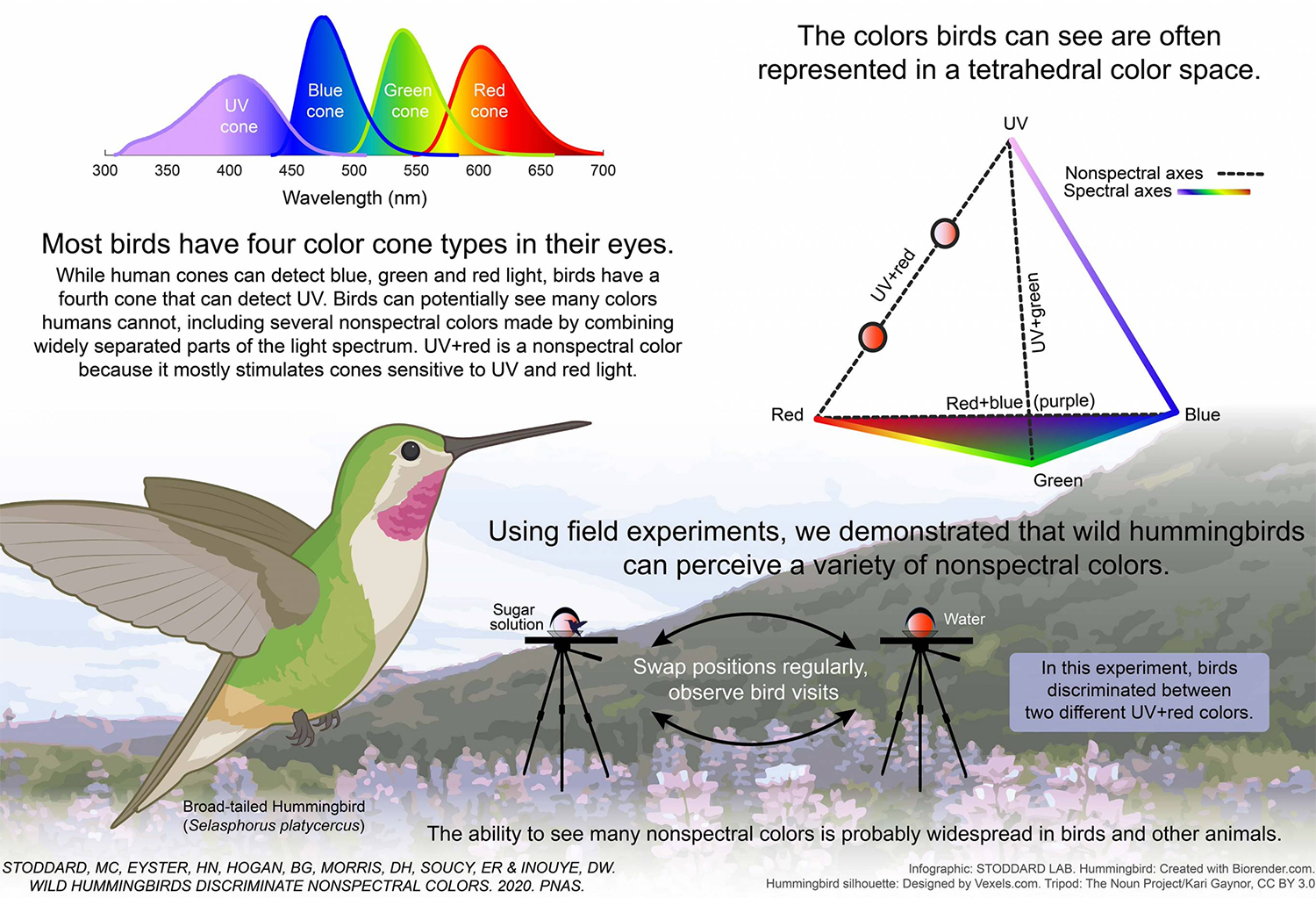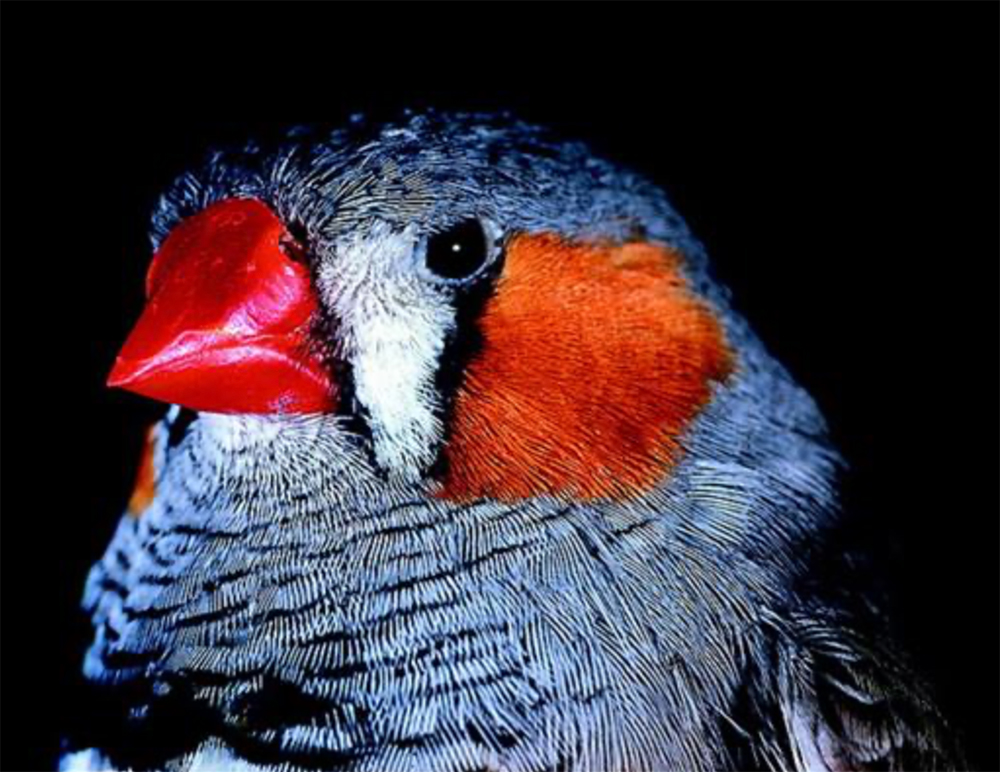Series 3: birds
VIEW & DOWNLOAD ARTICLES
Bird colour vision – from cones to perception
Highlights
- Bird colour vision depends on opsins, retinal mosaic, ocular media and oil droplets.
- Birds use spectral cues for phototaxis, magnetoreception and circadian control.
- Birds have fine colour discrimination and colour constancy.
- Colour vision is impaired in dim light, and with contrasting backgrounds.
- Birds can generalize similar colours and have categorical colour perception.
Wild hummingbirds see a broad range of colors humans can only imagine
By Liz Fuller-Wright, Office of Communications
To find food, dazzle mates, escape predators and navigate diverse terrain, birds rely on their excellent color vision.
“Humans are color-blind compared to birds and many other animals,” said Mary Caswell Stoddard, an assistant professor in the Princeton University Department of Ecology and Evolutionary Biology. Humans have three types of color-sensitive cones in their eyes — attuned to red, green and blue light — but birds have a fourth type, sensitive to ultraviolet light. “Not only does having a fourth color cone type extend the range of bird-visible colors into the UV, it potentially allows birds to perceive combination colors like ultraviolet+green and ultraviolet+red — but this has been hard to test,” said Stoddard.

Birds’ Eye View Is Far More Colorful Than Our Own
June 22, 2011
The brilliant colors of birds have inspired poets and nature lovers, but researchers at Yale University and the University of Cambridge say these existing hues represent only a fraction of what birds are capable of seeing.
The brilliant colors of birds have inspired poets and nature lovers, but researchers at Yale University and the University of Cambridge say these existing hues represent only a fraction of what birds are capable of seeing.
The findings based on study of the avian visual system, reported in the June 23 issue of the journal Behavioral Ecology, show that over millions of years of evolution plumage colors went from dull to bright as birds gradually acquired the ability to create newer pigments and structural colors.
Avian UV vision enhances leaf surface contrasts in forest environments
Published:
Abstract
UV vision is prevalent, but we know little about its utility in common general tasks, as in resolving habitat structure. Here we visualize vegetated habitats using a multispectral camera with channels mimicking bird photoreceptor sensitivities across the UV-visible spectrum. We find that the contrast between upper and lower leaf surfaces is higher in a UV channel than in any visible channel, and that this makes leaf position and orientation stand out clearly. This was unexpected since both leaf surfaces reflect similarly small proportions (1–2%) of incident UV light. The strong UV-contrast can be explained by downwelling light being brighter than upwelling, and leaves transmitting < 0.06% of incident UV light. We also find that mirror-like specular reflections of the sky and overlying canopy, from the waxy leaf cuticle, often dwarf diffuse reflections. Specular reflections shift leaf color, such that maximum leaf-contrast is seen at short UV wavelengths under open canopies, and at long UV wavelengths under closed canopies.
Taking a Bird’s-Eye View…in the UV: Recent studies reveal a surprising new picture of how birds see the world
BioScience, Volume 50, Issue 10, October 2000, Pages 854–859
People have long delighted in the vibrant colors of birds. Charles Darwin, for one, wrote extensively on their “beautiful plumes” and “brilliant tints.” Indeed, the varied and attractive coloration of birds—and the obvious importance of vision in their biology—has made them favored organisms for biologists studying visual communication. Avian research has played key roles in the study of visual signaling and in the burgeoning field of sexual selection. Biologists studying sexual selection have documented for one bird species after another whether females choose brighter-feathered males, whether plumage luster correlates with health, whether highly ornamented individuals win in male–male encounters, and whether particular colors and patterns have specific functions.
But do we really know how beautiful and brilliant bird coloration can be? In recent years, some researchers have found evidence that we don’t. A bird, it turns out, may be more colorful to another bird than to the human eye. For unlike humans, birds can perceive wavelengths in the ultraviolet as well as the visible range of the spectrum. So a bird is able to see ultraviolet “colors” in another bird’s plumage that humans cannot.
Because knowing what an animal really sees is a crucial first step toward understanding its behavior, many behavioral and ecological studies are now taking into account differences between avian and human vision. Scientists using technology to view, describe, and experimentally alter avian plumage in the UV range have already reinterpreted old views of signaling among birds in several systems, and these studies may be just the tip of the iceberg.

Zebra finches (Taeniopygia guttata) were the subject of some of the earliest research into the implications of ultraviolet (UV) vision for sexual signaling in birds, by Andrew Bennett, Innes Cuthill, and Julian Partridge, at the university of Bristol, England. This male zebra finch was photographed in visible light (top), and with UV light only (bottom, colored purple;areas that appear white reflect the most UV light). photo:© Andrew T.D.Bennett, University of Bristol

Zebra finches (Taeniopygia guttata) were the subject of some of the earliest research into the implications of ultraviolet (UV) vision for sexual signaling in birds, by Andrew Bennett, Innes Cuthill, and Julian Partridge, at the university of Bristol, England. This male zebra finch was photographed in visible light (top), and with UV light only (bottom, colored purple;areas that appear white reflect the most UV light). photo:© Andrew T.D.Bennett, University of Bristol
What If We Could See All Wavelengths Of Light?
Published On: 15 Aug 2016
Light is a form of electromagnetic radiation that consists of components with different wavelengths. You might already know that visible light, i.e. the light that we actually see and perceive, is just a small portion of all the light there is. So, what if we could see all the other components of the spectrum as well?
Let’s start with the left extreme of the spectrum…
“If we could see all wavelengths of light, it would be overwhelming and confusing. We would not be able to see colors, and everything would appear in different tones of heat. We would be able to see through other objects, but people would appear less like their usual selves and more frightening instead.

